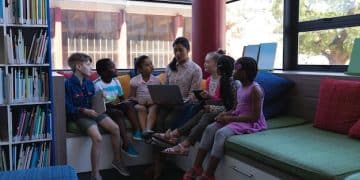Learning Styles and Online Education: Thriving in Virtual Environments

Learning styles and online education intersect to create unique challenges and opportunities, requiring educators and learners to adapt teaching and studying approaches to foster success in virtual environments.
The digital age has revolutionized education, making learning more accessible than ever. However, the shift to online platforms requires students and educators alike to understand and adapt to different learning styles and online education..
Understanding Learning Styles in the Digital Age
In the realm of education, understanding how individuals learn best is crucial. This is where the concept of learning styles comes into play. Learning styles refer to the different ways people process and retain information. Recognizing and catering to these styles can significantly enhance the learning experience, especially in today’s rapidly evolving digital age.
The shift towards online education has brought about a new set of challenges and opportunities. Traditional teaching methods may not be as effective in a virtual environment, making it essential for educators to adapt their strategies to accommodate various learning styles. By understanding how students learn, educators can create more engaging and effective online courses that cater to diverse needs.
Overview of Key Learning Styles
Several models exist to categorize learning styles, including Visual, Auditory, Kinesthetic, and Reading/Writing (VARK). Each style represents a different preference for how individuals absorb information.
- Visual Learners: These learners benefit from seeing information. They learn best through diagrams, videos, and visual aids.
- Auditory Learners: Auditory learners prefer listening. They excel in lectures, discussions, and audio recordings.
- Kinesthetic Learners: Kinesthetic learners are hands-on learners. They learn best through practical experience, simulations, and movement.
- Reading/Writing Learners: These learners prefer written information. They thrive when taking notes, reading textbooks, and writing essays.
Understanding these key learning styles is the first step in creating an inclusive online learning environment. By incorporating various teaching methods that cater to different styles, educators can enhance student engagement and comprehension.
In conclusion, mastering the understanding of different learning styles is essential for both educators and students. Adapting to these styles in online education can significantly improve the overall learning experience, making education more effective and engaging for everyone involved.
The Importance of Adapting Teaching Methods Online
Adapting teaching methods is paramount in online education because the virtual environment presents unique challenges not found in traditional classrooms. The passive nature of some online formats can lead to disengagement, making adjustments necessary to keep students actively involved and motivated.
To create an effective online learning experience, educators must be versatile and open to using a variety of instructional strategies. This adaptability helps cater to diverse learning styles and ensures that all students have the opportunity to succeed.
Strategies for Visual Learners
Visual learners thrive on seeing information presented in a clear and organized manner. Here are some effective strategies for engaging visual learners in an online setting:
- Use of Infographics: Present complex information using visually appealing infographics.
- Video Lectures: Incorporate video lectures with dynamic visuals to explain concepts.
- Mind Maps and Diagrams: Use mind maps and diagrams to illustrate relationships between different ideas.
Strategies for Auditory Learners
Auditory learners benefit from hearing information. To cater to auditory learners in online education, consider the following:
- Podcast-Style Lectures: Provide audio lectures that students can listen to at their convenience.
- Online Discussions: Engage students in online discussions and webinars.
- Verbal Instructions: Give clear verbal instructions and explanations during lessons.

By adapting teaching methods to suit visual and auditory learners, educators can create a more inclusive and effective online learning environment. These strategies not only enhance engagement but also improve overall comprehension and retention.
In summary, adjusting teaching methodologies is integral to online education. Using approaches that resonate with learners ensures a richer, more engaging, and ultimately more successful educational journey.
Technology’s Role in Catering to Different Learning Styles
Technology has revolutionized the way we approach education, offering a myriad of tools and platforms that can be tailored to accommodate diverse learning styles. From interactive simulations to personalized learning paths, technology plays a pivotal role in creating an inclusive and effective online learning environment.
By leveraging technological resources, educators can provide students with a rich and varied learning experience that caters to their individual needs and preferences. This personalization not only enhances engagement but also fosters a deeper understanding of the subject matter.
Interactive Simulations and Virtual Labs
For kinesthetic learners, interactive simulations and virtual labs offer a hands-on learning experience that mimics real-world scenarios. These tools allow students to actively engage with the material, experiment with different variables, and learn by doing.
Adaptive Learning Platforms
Adaptive learning platforms use algorithms to assess a student’s knowledge and adjust the difficulty of the material accordingly. These platforms provide a personalized learning experience that caters to each student’s unique pace and style, ensuring that they are always challenged but not overwhelmed.
Here are some key benefits of adaptive learning platforms:
- Personalized Learning Paths: Tailor-made learning experiences that adapt to individual needs.
- Real-Time Feedback: Immediate feedback on performance, helping students identify areas for improvement.
- Progress Tracking: Continuous monitoring of progress, providing insights into strengths and weaknesses.
Technology’s role in catering to different learning styles is transformative. By utilizing simulations, adaptive learning platforms, and multimedia resources, educators can create a dynamic and engaging online learning experience that meets the diverse needs of all students.
In conclusion, technology is a powerful ally in online education. It enhances personalization, engagement, and adaptability, creating an environment where all learning styles are catered to effectively.

Creating an Inclusive Online Learning Environment
Creating an inclusive online learning environment involves designing courses that accommodate a variety of learning styles and needs. This approach ensures that all students have equal opportunities to succeed, regardless of their individual preferences or challenges.
An inclusive environment not only enhances engagement and comprehension but also fosters a sense of belonging and support. This holistic approach to education helps students feel valued and motivated, leading to better academic outcomes.
Design Considerations for Diverse Learners
When designing online courses, educators should consider the following factors to create an inclusive learning environment:
- Accessibility: Ensure that all course materials are accessible to students with disabilities.
- Variety of Content Formats: Offer content in multiple formats, such as text, audio, and video.
- Flexible Deadlines: Provide flexible deadlines to accommodate students with different schedules and needs.
These design considerations can significantly improve the learning experience for diverse learners, making online education more equitable and effective.
Promoting Peer Interaction and Collaboration
Peer interaction and collaboration are essential components of an inclusive online learning environment. These activities provide opportunities for students to learn from each other, share ideas, and build a supportive community.
Here are some strategies for promoting peer interaction and collaboration:
- Group Projects: Assign group projects that require students to work together.
- Discussion Forums: Create online discussion forums where students can share their thoughts and ideas.
- Peer Review: Implement peer review activities where students provide feedback on each other’s work.
By promoting peer interaction and collaboration, educators can foster a sense of community and support in the online learning environment, enhancing student engagement and motivation.
In summary, building an inclusive online classroom involves deliberate design, accessibility, varied content, and chances for cooperation. These factors guarantee that every student, irrespective of learning style, can prosper in a virtual environment.
Assessing Learning and Providing Feedback in Online Settings
In online education, assessing learning and providing feedback are critical components of the instructional process. These practices help students gauge their understanding of the material, identify areas for improvement, and stay motivated throughout the course.
Effective assessment and feedback not only enhance learning outcomes but also foster a sense of connection and support between students and instructors. This interaction is particularly important in the online environment, where students may feel isolated or disconnected.
Formative vs. Summative Assessments
Formative assessments are ongoing evaluations that provide feedback to students throughout the course. These assessments are designed to help students learn and improve, rather than to assign a grade.
Summative assessments, on the other hand, are evaluations that are given at the end of a unit or course to measure student learning. These assessments are typically used to assign a grade.
Here are some examples of formative and summative assessments:
- Formative Assessments: Quizzes, discussion forums, peer reviews.
- Summative Assessments: Final exams, research papers, projects.
Strategies for Providing Effective Feedback
Providing effective feedback is essential for helping students improve their learning. Here are some strategies for providing constructive feedback in online settings:
- Be Specific: Provide detailed feedback that focuses on specific areas for improvement.
- Be Timely: Provide feedback as soon as possible after the assessment.
- Be Constructive: Focus on what students can do to improve, rather than just pointing out their mistakes.
Providing comprehensive feedback guarantees that scholars receive the advice they require to improve their understanding and skills.
In conclusion, assessment and feedback are necessary within virtual training. Continuous formative evaluations accompanied by constructive assessment support students’ progress and support a supportive context, culminating in better educational consequences.
The Future of Learning Styles in Online Education
As technology continues to evolve, the future of learning styles in online education is poised for significant transformation. Emerging technologies, such as artificial intelligence and virtual reality, offer new opportunities to personalize learning experiences and cater to diverse learning styles in innovative ways.
By embracing these advancements, educators can create online courses that are more engaging, effective, and inclusive than ever before. This forward-thinking approach will not only enhance student learning but also prepare them for success in a rapidly changing world.
Emerging Technologies and Personalized Learning
Emerging technologies, such as artificial intelligence (AI) and virtual reality (VR), have the potential to revolutionize online education by providing personalized learning experiences that cater to individual learning styles. AI-powered platforms can analyze student data to identify learning patterns and preferences, and then tailor the learning content and activities accordingly. VR can create immersive learning environments that simulate real-world scenarios, providing kinesthetic learners with hands-on experiences that enhance their understanding.
Here are some examples of how emerging technologies can be used to personalize learning:
- AI-Powered Tutors: Virtual tutors that provide personalized instruction and feedback.
- VR Simulations: Immersive simulations that allow students to practice skills in a safe and engaging environment.
- Adaptive Content: Learning materials that adapt to each student’s unique pace and style.
The Role of Adaptive Learning Platforms
Adaptive learning platforms are set to play a pivotal role in the future of online education. These platforms use algorithms to assess a student’s knowledge and adjust the difficulty of the material accordingly, providing a personalized learning experience that caters to each student’s unique pace and style. Adaptive learning platforms can also provide real-time feedback on performance, helping students identify areas for improvement and stay motivated throughout the course.
In summary, virtual learning is poised for exceptional transformation. Emerging technologies and adaptive environments are anticipated to personalize the learning experience and accommodate diverse learning styles in novel manners, leading to improved outcomes for both learners and teachers.
| Key Concept | Brief Description |
|---|---|
| 💡 Learning Styles | Different ways students process and retain information. |
| 💻 Online Adaptation | Adjusting teaching for virtual environments. |
| 🛠️ Technology Integration | Using tech to support varied learning styles. |
| 🤝 Inclusive Design | Creating equitable opportunities for all learners. |
Frequently Asked Questions
▼
The main styles are visual, auditory, kinesthetic, and reading/writing. Each describes how individuals prefer to process and retain information, impacting educational strategies.
▼
Use infographics, videos, and diagrams to present information. Visual aids enhance comprehension and engagement, tailored to visual learning preferences in digital settings.
▼
Podcast lessons, online discussions, and verbal instructions cater to auditory learners. Listening and active participation boost retention in virtual educational landscapes.
▼
Interactive simulations and virtual labs engage kinesthetic learners. Hands-on experiences replicate real-world scenarios, fostering improved understanding through practical engagement.
▼
Technology enhances accessibility and customizes educational experiences. It enables personalized instruction, adapting content to diverse needs, promoting improved academic experiences.
Conclusion
Adapting to different learning styles in online education is essential for fostering a more effective and inclusive learning environment. By understanding and applying strategies that cater to visual, auditory, kinesthetic, and reading/writing learners, educators can create engaging and personalized experiences that enhance student success in the digital age.





